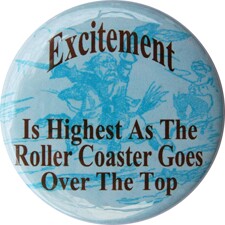Stock Market Video
A Field Guide to American Stock Indexes
Excitement Is Highest As the Roller Coaster Goes Over The Top
In Case You Missed It
---
In this week’s Stock Market Video, Mike Cintolo discusses a few yellow flags, but remains generally bullish on the market. He thinks volatility is likely to pick up again, but there are a few stocks that have consolidated nicely in recent weeks to keep your eye on. Stocks mentioned include: NXP Semiconductors (NXPI), Goldman Sachs (GS), Ford Motor (F), Continental Resources (CLR), Oasis Petroleum (OAS) and Aruba Networks (ARUN). Click below to watch the video!
---
Understanding Stock Market Indexes
On most evening news shows, both TV and radio, there’s usually a quick one-liner about the stock market’s performance for the day that goes something like this: “The Dow closed the day up (or down) xx points.”
For people who aren’t familiar with either the market or the Dow, this is virtually meaningless. After all, most people have no idea how big a 100-point swing in the Dow represents (with the Dow around 14,500, it’s about 2/3 of a percent).
Here at Cabot we use indexes a lot; they’re central to our method of market timing. It’s more complicated than this, but when an index (or a basket of indexes) is above its 25-day and 50-day moving averages, it tells us that the intermediate-term trend is up, and thus, the markets are generally healthy. And that’s a time to move toward a heavily invested position.
I thought it would be useful for you to know what the most common indexes actually represent and how they’re calculated. And a possible side benefit may be that you’ll want to rethink those index funds that may make up a large part of your investment portfolio. (If your mutual fund company is managing your money against a benchmark index, it’s very much to your advantage to know as much about it as possible.) Here are the three best-known indexes.
The Dow
The Dow, the familiar name for the Dow Jones Industrial Average, represents the performance of 30 of the largest companies that trade on U.S. exchanges, selected for their leadership in their industries. Collectively, these companies (and their $4.25 trillion market cap) represent a hair under 20% of the total market capitalization of the combined New York Stock Exchange and the Nasdaq.
The 30 members of the Dow range from titans like ExxonMobil (with a market cap of nearly $400 billion) to Alcoa (market cap $9 billion), and their impact on the index is proportional to their stock prices, not their market value. So IBM, which has just rallied to 215, has nearly eight times more influence on the movement of the Dow than Microsoft, which is trading around 28.
The Dow has plenty of critics, but it’s been around since 1896 and it’s got high name recognition, so it’s not likely to get the axe any time soon. The companies that make it up are stable, pay regular dividends and don’t dance around in disconcerting ways, which makes it popular with more conservative investors.
At this point, probably the Dow’s biggest benefit is that it’s trading at new all-time highs, which may coax more money off the sidelines and into the market.
The Dow is now trading at around 14,450, which means it would have to trade up or down by 145 points to register a 1% move.
The S&P
The S&P 500 Stock Index was formulated in 1957, and is widely considered to be the best proxy for the U.S. stock market. The S&P is capitalization weighted, so the bigger the market cap, the bigger its effect on the Index. The total market cap of the S&P is about $10.7 trillion, although that number varies with market moves. The Index represents about 70% of the total capitalization of the U.S. market.
The folks who put together the S&P don’t just go for the 500 largest companies. They build the index to represent all sectors and industries, but all the firms are relatively large.
The S&P 500 is now trading above 1,500, which means that a 15-point swing reflects a 1% move. That’s important to know when news stories give just point changes in the major indexes, because the Dow’s moves will typically be much larger, even though the percentage change may be about the same.
The Nasdaq
The Nasdaq Composite Index began life in 1971 as an electronic price quotation system (the name comes from National Association of Securities Dealers Automated Quotations). The Nasdaq service gradually morphed into an online stock exchange and is now the second largest stock exchange in the world by market capitalization.
The Nasdaq Composite is a capitalization-weighted representation of the more than 3,000 equities listed on the Nasdaq Exchange. The Nasdaq Exchange has always been attractive to technology stocks and growth issues—in fact, back in the 1970s, it was more of a small-cap index as many newer firms listed there. But today it’s often referred to in news stories as “the tech-heavy Nasdaq,” as many of the biggest components are from that sector. Accordingly, the Nasdaq Composite is taken to be a proxy for investors’ risk tolerance, rising strongly when investors are feeling aggressive and falling when they’re feeling conservative.
The Nasdaq has been trading above 3,200 in recent days, which puts a 1% change at about 32 points.
The three major U.S. indexes tend to trade up and down in tandem, although the Dow will typically show the least volatility of the three and the Nasdaq the most.
As a growth investor, I look for differences in the movements of the three indexes for insight into how investors are feeling. I think it’s significant that when the Dow and the S&P hit new highs recently, it took the Nasdaq longer to follow suit. And, of course, the Nasdaq is a long, long way from its all-time high (5133) at the Tech Bubble top. Conversely, when the Dow is outperforming the other two, it can indicate that investors are looking for value and lower risk.
When it comes to intermediate-term market timing, the most important thing about any index is its relationship to its 25-day and 50-day moving averages. When indexes are above those moving averages, buyers are in control and growth investors should be putting more money to work in strong growth stocks.
I can’t emphasize enough how important this simple signal is! It can get you into bull markets much more reliably than guesswork or trusting your own gut feelings. And, even more important, it can get you out of bear markets before real damage is done.
Yes, you’ll suffer a few whipsaws along the way, but you’ll never miss a major bull move, nor remain stuck in a major bear move. And that’s a big deal.
Knowing your indexes can help make you a savvier investor.
--- Advertisement ---
If This Week’s Trades Don’t Hand You at Least 30% Profits in 60 Days--You Won’t Pay a Dime
Cabot Top Ten Trader’s results have left our readers smiling all the way to the bank, with annualized profits of up to 50% on each of our trades--coming in as little as 30 days.
All thanks to breakout winners like these ...
* Continental Resources 122%
* Encore Aqua 101%
* Cleveland Cliffs 93%
* DryShips 95%
* McMoRan Exploration 91%
* M&F Worldwide 78%
Don’t wait until after the next economic reports come out or the big profits will have passed you by. If you’re serious about grabbing your share of profits from these trades, now is the time to join us ...
---
Here’s this week’s Contrary Opinion Button. Remember, you can always view all of the buttons by clicking here.
Excitement Is Highest As the Roller Coaster Goes Over The Top
Tim’s Comment: Cabot founder Carlton Lutts loved this one; he wore it on his jacket with some regularity. The lesson: When everyone’s excited, the market’s usually near a top, at least shorter-term. As I write this, I can clearly remember the euphoric state of mind of my colleagues and customers at each of the past five major market tops. And just as clearly, I know that state of mind will recur at the next major market top. When it comes, you should mentally begin to prepare for the coming bear market.
Paul’s Comment: Part of becoming a market veteran is learning to grow more apprehensive as investors get happiest and more optimistic as they hide in the depths of despair. If you think this sounds like just another market paradox, you’re wrong. When everyone in the market is happy as they can be, the only change possible is to get less happy. And that’s why it’s best to be a little cold-blooded about big market rallies that have been running for a long time, especially if there are no doubters left.
---
In case you didn’t get a chance to read all the issues of Cabot Wealth Advisory this week and want to catch up on any investing and stock tips you might have missed, there are links below to each issue.
Cabot Wealth Advisory 3/11/13—How to Start a New Investment Strategy
Robin Carpenter, editor of Cabot ETF Investing System, writes in this issue about the best way to start investing using a new strategy. Robin recommends taking your time to pick the strategy, but jumping in with both feet once you pick the right system for you.
Cabot Wealth Advisory 3/12/13—Two Stocks that Will Not Decline
In this issue, Cabot Benjamin Graham Value Letter expert Roy Ward points out that a strong economy and a strong stock market seldom coincide. This points to a strong stock market ahead. Stocks discussed: CVS Caremark (CVS) and Walt Disney (DIS).
Cabot Wealth Advisory 3/14/13—Introducing Jacob Mintz, Editor of Cabot Options Trader
In this issue, I have the pleasure of welcoming Jacob Mintz, the new editor of Cabot Options Trader, to the Cabot family. Jacob’s story is a compelling one, and I interviewed him to get the inside story on his remarkable career as an options trader.
Have a great weekend,
Paul Goodwin
Editor of Cabot China & Emerging Markets Report
and Cabot Wealth Advisory


